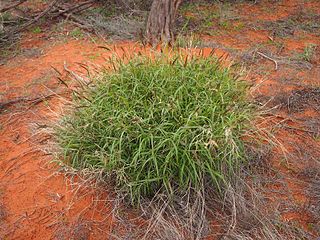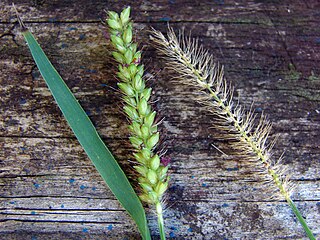
Timothy is an abundant perennial grass native to most of Europe except for the Mediterranean region. It is also known as timothy-grass, meadow cat's-tail or common cat's tail. It is a member of the genus Phleum, consisting of about 15 species of annual and perennial grasses.

Alopecurus pratensis, known as the meadow foxtail or the field meadow foxtail, is a perennial grass belonging to the grass family (Poaceae). It is native to Europe and Asia.

Alopecurus, or foxtail grass, is a common and widespread genus of plants in the grass family. It is common across temperate and subtropical parts of Eurasia, northern Africa, and the Americas, as well as naturalized in Australia and on various islands.
Foxtail or fox tail may refer to:

Cenchrus ciliaris is a species of grass native to most of Africa, southern Asia, southern Iran, and the extreme south of Europe (Sicily). Other names by which this grass is known include dhaman grass, anjan grass, koluk katai and buffelgrass.

Agrostis stolonifera is a perennial grass species in the family Poaceae. It is widely used as turf for golf courses.
British NVC community MG13 is one of the mesotrophic grassland communities in the British National Vegetation Classification system. It is one of three types of mesotrophic grassland classified as grass-dominated inundation communities.
British NVC community MG4 is one of the mesotrophic grassland communities in the British National Vegetation Classification system. It is one of four such communities associated with well-drained permanent pastures and meadows.

Gavojdia is a commune in Timiș County, Romania. It is composed of four villages: Gavojdia, Jena, Lugojel and Sălbăgel.

Alopecurus aequalis is a common species of grass known as shortawn foxtail or orange foxtail. It is native to much of the temperate Northern Hemisphere from Eurasia to North America. It is most commonly found in areas near fresh water, such as the margins of ponds and ditches.

Alopecurus carolinianus is a species of grass known by the common names Carolina foxtail and tufted foxtail.

Alopecurus geniculatus is a species of grass known by the common name water foxtail or marsh foxtail. It is native to much of Eurasia and introduced into North America, South America, and Australia. It grows in moist areas.

Alopecurus saccatus is a species of grass known by the common name Pacific foxtail, or Pacific meadow foxtail.

Pennisetum alopecuroides, the Chinese pennisetum, Chinese fountaingrass, dwarf fountain grass, foxtail fountain grass, or swamp foxtail grass, is a species of perennial grass native to Asia and Australia. The culms are erect, and 60–100 cm long. The leaf-blades are erect or drooping; flat, or conduplicate or involute (spiral); and from 10 to 45 cm long by 3–6 mm wide.

Setaria viridis is a species of grass known by many common names, including green foxtail, green bristlegrass, and wild foxtail millet. It is sometimes considered a subspecies of Setaria italica. It is native to Eurasia, but it is known on most continents as an introduced species and is closely related to Setaria faberi, a noxious weed. It is a hardy grass which grows in many types of urban, cultivated, and disturbed habitat, including vacant lots, sidewalks, railroads, lawns, and at the margins of fields. It is the wild antecedent of the crop foxtail millet.

Setaria parviflora is a species of grass known by the common names marsh bristlegrass, knotroot bristle-grass, bristly foxtail and yellow bristlegrass. It is native to North America, including Mexico and the United States from California to the East Coast, Central America and the West Indies, and South America.
Alopecurus creticus, the Cretan meadow foxtail, is a species of foxtail grass.
Alopecurus setarioides is a species of foxtail grass that is found in France, Greece, Italy and Turkey. It prefers wet places, including ditches.
Urocystis alopecuri is a fungal plant pathogen in the family Urocystidiaceae. Known as 'Foxtail Smut'.














